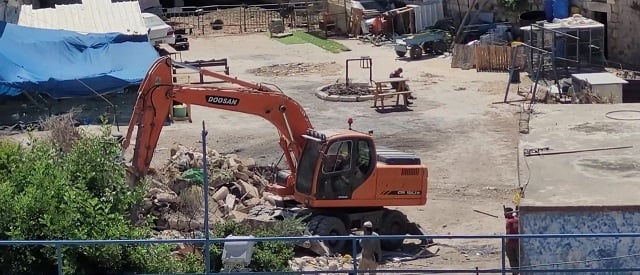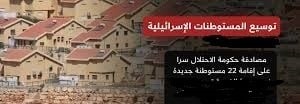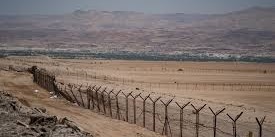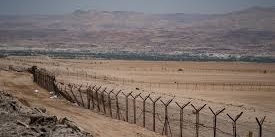By: Madeeha Al-A’raj
The national Bureau for Defending Land and Resisting Settlements stated in its latest weekly report , that Za’tara Wilderness in Bethlehem city returns to the front of the Israeli Occupation Authorities’ policy of destruction, as they are planning to demolish a village east of the city, and allowing the establishment of new settlement outposts there, which the Palestinian, and Israeli anti-settlement organizations have described them as dens of terror and violence, of which the ‘Makneh Avraham’ outposts.
For its part, the Israeli B’Tselem stated that ‘since the establishment of these outposts, the Palestinians have been subjected to repeated violence, and many attempts to expel them from their lands, to help[ allow settlers’ spread from Area C to Area B.’ Furthermore, Yonatan Mizrahi of the Peace Now Movement said, ‘the establishment of outposts in Area B and the systematic demolition of Palestinian structures is a new stage in the annexation policy that taking place in the occupied territories, added that Netanyahu and Smotrich are enabling illegal and unprecedented construction by settlers, alongside the obsessive preoccupation in Area B, is an Israeli strategic decision to end the agreements signed with the Palestinians.’
The Occupation Authorities have recently demolished 2 houses and 3 concrete walls in the Al-Malha village, Bethlehem, which hindered the construction of a project there, to improve the standard of living of Palestinians. Mayor of the village, Murad Jadal told the Israeli Haaretz Newspaper that, “We have plans to establish a model village with gardens and organized roads in the village, but the sudden Israeli decision banned anything, adding that many citizens were affected by that”. Moreover, a citizen commented on that as saying: “I bought a land there in 2023 and I started building my house, but after Israeli FM Smotrich’s decision to stop construction, I couldn’t proceed to complete it. So, my family was left homeless.”
Knowing that, the Al-Malha village was established in Area B to the east of Bethlehem by Palestinian citizens, and controlled by the Palestinian Authority under the Wye River Agreement that signed in 1998 at the White House by the Israeli PM Benjamin Netanyahu, the Palestinian President Yasser Arafat, and US President Bill Clinton. It stipulated the Israeli withdrawal from some areas of the West Bank, where the civil responsibility will be transferred to the Palestinian Authority, including the Bethlehem Wilderness, and the second redeployment of Israeli forces in the West Bank would take place in 3 stages. Noting that, it was agreed to transfer the Za’tara Wilderness in Area B to a natural reserve.
Head of the so-called ‘Gush Etzion Settlement Council’, Yaron Rosenthal said the demolition plan is for security reasons, adding that “the establishment of a new Palestinian town in the area represents a security threat, and the Israeli intervention there is to keep the area open for strategic purposes, and to prevent any presence that could pose a security threat to the settlements.” For its part, the NGO’s ‘Regavim’, which sponsors settlements and funds settler terrorism, was co-founded by Smotrich and the lobby of ‘Israel Land’ at the Knesset, welcomed the demolition plan and the so-called ‘law enforcement operation.’
Minister of Finance and Minister of Settlement in the Ministry of Army,Smotrich, who is responsible for managing settlements and the Civil Administration, said, “The Palestinian Authority’s plan to cut off the connection between Gush Etzion and Jerusalem is unacceptable. We will not allow a violation of the law that will lead to the establishment of a Palestinian state and endanger settlement and security in the area, and we will keep the State of Israel and the security of its citizens.”
Smotrich announced last August the imposition of civil and administrative control over the vast wilderness areas under the pretext of security and being ‘natural reserves. So, the Israeli settlement associations will stay in the Za’tara wilderness. Since then or before, the harassment began as settlers, delegations, Knesset members and ministers weekly come to Al-Malha, Bethlehem, including head of the Yisrael Beiteinu Party, Avigdor Lieberman, and Smotrich himself, and gives promises to the settlers to remove Palestinian infrastructure there.
Some Israelis escalate pace to change reality on the ground before Trump take office in the White House, as Smotrich and his men have emphasized to connect the Gush Etzion with Jerusalem. Among other things, the administration of ‘law enforcement’ has carried out demolitions in the Walaja Valley area, which is located in the same area. Moreover, during a campaign, led by the so-called Etzion Control and Supervision Unit, exsisting buildings were demolished and temporary ones were removed. In mid-Dec. additional work was carried out in Wadi Fukin, which is also in Gush Etzion, where about 20 olive trees and other crops were uprooted. So far, what the occupation authorities call 11 enforcement ‘demolition\ operations have taken place in the Walaja area, 7 in the reserve and 5 in Wadi Fukin.
Last July, the cabinet approved the establishment or retroactive legalization of 5 settlements located at strategic points in the area. These block Palestinian contiguity, and create settlement contiguity. Furthermore, Smotrich is trying to change the reality in the West Bank as part of preparations for the Trump Administration to enter the White House with dreams of sovereignty in the West Bank. The goal is to present the president-elect with a sovereignty plan based on status quo.
On the issue of security and law enforcement, the occupation government, Smotrich and his Civil Administration, and the Gush Etzion settlement council are lying. Right-wing Knesset members, along with government ministers and some of the opposition, initially wanted to claim that the Palestinians in this area were harming nature or security. However, in a session of the Foreign Affairs Committee last May, the legal adviser for the West Bank in the Military Advocate General’s Office, Eli Libertov, said that there was no valid opinion that there was harm to nature.
Adding that, the then-commander of the Central Command, Yehuda Fuchs, did not believe that the construction itself posed any security risk. So why to take action now, after 5 years of construction in the aforementioned village? Shaul Arieli, head of the Ramzor research group, who participated in drafting the Wye River agreement, said that declaring the area a reserve did not stem from a desire to preserve nature, but rather from Netanyahu’s intention to pave st. 80, which will be an extension of the Ayalon Road. According to Arieli, the claim that the Palestinian Authority is violating the agreement applies tenfold to the State of Israel, which violates the obligations unilaterally and repeatedly.
It is the same destructive policy that the occupying state is pursuing, but its role here is complementary to the role of the Jewish terrorist organizations, which launch from the settlements and settlement outposts in ethnic cleansing operations in many areas in the West Bank, from the areas of the Jordan Valley to the Jordan Valley itself to the areas south of the Hebron Mountain.
Noteworthy here that according to the National Bureau, Colonization and Wall Resistance Commission, and Israeli and international organizations and bodies’ identical data over the last 2 years, 26 population centers have been completely erased, which led to the displacement of 405 families, comprising 2,497 individuals, population centers, each comprising 45-50 families, were displaced, which reinforces the argument that this is part of a large-scale and systematic effort to remove Palestinian communities. Besides, the number of partially displaced population centers now stands at 15, comprising 247 families and 713 people. In total, 652 families, representing 3,210 people, were displaced from their homes.
Moreover, 16 communities remain under imminent threat of displacement, endangering the lives of 423 Palestinian families with a total population of 3,406 people. These figures highlight the systematic and widespread nature of the efforts by the occupying state and Jewish terrorist organizations operating in the settlements to forcibly remove Palestinian communities, highlighting the urgent need for Palestinian, regional and international action to halt this destructive policy.
On the other hand, settlers keep storming the Al-Aqsa Mosque under heavy guard by the occupation forces. They carried out provocative tours and Talmudic rituals in its courtyards and receive explanations about the alleged temple before leaving the place. On their religious holidays, the provocations reach their peak, especially when government officials participate. Last week, the so-called Minister of National Security, Itamar Ben Gvir, led these storms on the first day of the so-called ‘Lights Festival – Hanukkah’. This is the 7th time Ben Gvir storms the courtyards of the mosque since he took his ministerial position, and the 4th time since the brutal war waged by the occupation State on the Gaza Strip.
List of Israeli Assaults over the Last Week Documented by the National Bureau:
Jerusalem:
- Forcing citizens Hani Shakirat in the Jabal Mukaber town, Mahmoud Aqil and Hisham Aqil in Silwan town, and Jalal Al-Atrash in Sur Baher to demolish their homes under the pretext of building without a permit. The occupation municipality also handed a citizen from the Obeidat family a demolition order for his home in Jabal Mukaber town.
- Demolishing 2 apartments belonging to citizen Moh’d Salah and his son, under the pretext of paving a road in the site. The occupation’s machinery also demolished a commercial facility in Beit Hanina town, belonging to citizen Moh’d Al-Halhouli, under the pretext of not having a permit.
- bulldozing 200m2 for citizen Fares Salah Al-Din, in the Hizma town, and a house under construction belonging to citizen Habis Ali., bulldozed olive trees and stone chains during in the town.
Hebron:
- Attacking citizens’ homes in the Susya village in the Masafer Yatta area, where they threw stones at the homes, uprooted crops and trees, and vandalized property surrounding the homes of citizens Hussein al-Nawaj’a and Yousef al-Nawaj’a, where their crops were destroyed. In Masafer Yatta, settlers also installed an iron gate near citizens’ homes in Khirbet al-Mafqara, while others attacked citizens’ property in the Um al-Simsim area in the Dhahiriya town, south of Hebron, and destroyed an agricultural room belonging to citizen Samer Abu Sharkh.
- Demolishing a home belonging to citizen Moh’d Haroun Halayqa on the pretext that construction is prohibited in the village of Shuyukh al-Arroub. The occupation forces also seized a digger owned by citizen Rawdi al-Jabarin under the pretext of working in Area C located in Wadi al-Jawaya in Masafer Yatta. In Masafer, settlers from a number of settlement outposts also stormed the tin houses, tents and caves in Khirbet al-Halawa, and terrorized children and residents.
- Storming the archaeological area of Tel Ma’in and set up huts near citizens’ homes and performed biblical rituals in the Sha’b al-Batam area south of Hebron.
Bethlehem:
- Closing the entrance of the Wadi Fukin village with stones, and prevented vehicles and citizens from passing.
- Demolishing a park and a swimming pool in the Khallet Al-Daliya area, south of the Nahalin town, which contained a restaurant, a swimming pool and recreational facilities belonging to the citizen Abdul Rahman Taie Fanoun, under the pretext of not having a license.
Ramallah:
- Attacking farmers in the Burqa village, east of Ramallah, attempted to force them leave the area, and in the Sinjil town, settlers attacked citizen Saed Abdul Baqi from Talfit, assaulted and expelled him at gunpoint from the area of Al-Ma’ashriya, located on the outskirts of the town.
- Attacking vehicles near the northern entrance of the Al-Bireh city, settlers also set fire to the lands of the Sinjil town, located in the area of Al-Ma’ashriya, knowing that its owners have been forbidden from accessing this area since the beginning of the war on Gaza, under the pretext that it is a closed military zone, according to the occupation’s claim.
Salfeet:
- Torching the Marda village’s Mosque, wrote racist slogans on its walls.
- Bulldozing lands and uprooted dozens of olive trees in the Haris village, belonging to Abdul Latif Daoud, who reported that the occupation forces continued to bulldoze his land in the Al-Dahr area on the western side of the village, for the benefit of the Israeli company ‘Mekorot’, which extends water lines to the settlement of Barkan, in an area surrounded by the industrial settlements of ‘Netafim and Barkan’.
Nablus:
- Storming the ‘Yosef Tomb’ under heavy security protection from the occupation forces, performed Talmudic rituals, amid an atmosphere of screaming, dancing and loud music.
Jenin:
- Demolishing a warehouse belonging to the Al-Jalameh Agricultural Association, for producing and selling agricultural fertilizers, an artesian well, and a garage for cars near the Al-Jalameh military checkpoint.
- Destroying agricultural room belonging to Naseem Jawad Amarneh in the Dahr al-Abed village.
Qalqilia:
- Demolishing a car repair garage in the Nabi Elias village, belonging to Mustafa Al-Shawfani.
- Bulldozing a facility used by workers near the eastern entrance of the Qalqilia city.
Tulkarem:
- Handing over a demolition order the two-story house belonging to the detainee Moh’d Talal Farid Abu Yassin in the Bal’a town, east of the Tulkaremcity.
Jordan Valley:
- Setting up a new settlement outpost on the lands of the Arab al-Malihat Bedouin community on the al-Mu’arjat road, northwest of Jericho. Settlers also grazed their sheep there, damaging citizens’ fodder and destroying property, burned two sheep pens containing fodder belonging to Hamza and Moh’d Ali Malihat.
- Attacking Ahmad Nasser Fuqaha’s vehicle with stones, broke its windshield in the Kardala village in the northern Jordan Valley.
- Setting up a new settlement outpost near a military checkpoint of the occupation forces, in the Qa’un Plain, west of the village of Bardala, as settlers brought agricultural tractor, water tank, fodder, and about 30 cows.
- Erecting the ‘candlestick symbol’ on the Diokos Castle ‘Al-Hawtah’, which is considered one of the ancient ruins in the Qarnatal Mountain, which dates back to the Byzantine era .
 المكتب الوطني للدفاع عن الارض ومقاومة الاستيطان منظمة التحرير الفلسطينية
المكتب الوطني للدفاع عن الارض ومقاومة الاستيطان منظمة التحرير الفلسطينية




